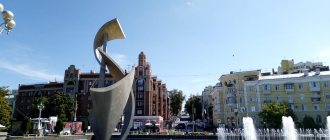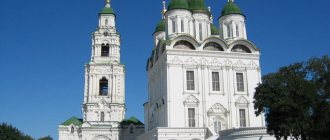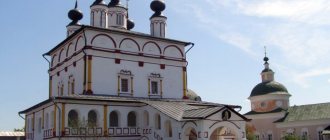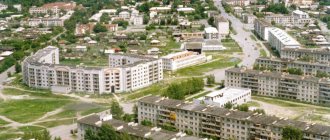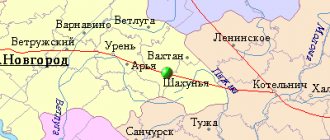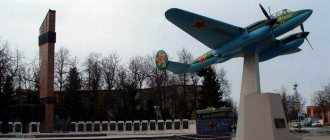| Chita, view from Titovskaya Sopka, beginning. 2010s Photo by Viktor Borisov |
Chita
, a city in Russia, the administrative center of the Trans-Baikal Territory, the cathedral city of the Chita diocese. Located in the Chitino-Ingodinskaya depression and on the slopes of the Yablonovy (from the west) and Chersky (from the east) ridges, at the confluence of the river. Chita in the district Ingoda, 6198 km east of Moscow. Large transport hub, railway. station, highway junction, airport. Population - 335,760 people (January 1, 2014) [1]
- On the map: Yandex.Map, Google map
The Mongoloid population lived on the territory of the city, starting from the Old Stone Age. In the Middle Ages, the Tungus lived here. At the end of October 1653, after an unsuccessful attempt at rafting along the river. Ingoda by the Cossacks of Peter Beketov at the mouth of the river. A winter hut was established in Chita [2]. Beketov sent a report to Yeniseisk: “And in Zimovye there is a sovereign’s barn, and three Cossack huts.
And in Zimovye and near Zimovye he ordered a fortress to be built. And he ordered the sovereign’s treasury to demolish the anbar” [3]. The first permanent settlement began to be called a raft (shown on N. Witsen’s map of Siberia in 1687), since rafts, planks, and later boats and barges were built here. In 1688 (1689), the Nerchinsk Cossack K. Yudin wrote “from the Chita River of the new settlement of the plot” to Ambassador F.A. Golovin about accepting grain reserves. The rapid development and settlement of the raft was facilitated by its advantageous position on the high road, the waterway to Eastern Transbaikalia and the Amur, to the Pacific Ocean. At the turn of the 17th - 18th centuries, in the vicinity of Chita, along the eastern slope of the Yablonovy Range, Buryats settled, having migrated from the Khorinsky steppes (the valley of the Uda River). Since the end of the 17th century, the village has been known successively as the Chitinskoye raft, Chitinskaya Sloboda, Chitinsky fort, Chitinskoye village, Chitinsk.
In 1726 a postal station was established. According to the revision of 1762, in Chita (without villages) there were 6 families of Cossacks, 14 families of commoners and 4 families of peasants, for a total of 73 inhabitants. In 1764 - 1765, the peasant population was assigned to the Nerchinsk silver smelter and included in the Gorodishchenskaya volost. In 1798, the fort came under the jurisdiction of the Nerchinsk Mining and Factory Administration; the main occupation of the population was supplying bread and burning charcoal for the Shilkino silver smelting plant.
Volost center. Decembrists
In 1823, Chita became the center of the Chita volost.
In 1827 - 1830, the Decembrists served hard labor here. The first plan of Chita was drawn up in 1830 by the Decembrist P.I. Falenberg. The development of Chita as a city was greatly facilitated by the Decembrist Dmitry Zavalishin. After the amnesty in 1839, he remained in a settlement in Chita and launched educational activities. Through his efforts, schools were opened for children of “every rank and class.” Using his own funds, he supplied schools with teaching aids and worked as a teacher himself. He passed on his experience to local residents in cultivating the land, selecting seeds, and growing crops unknown in Siberia.
Regional center. Development of the city in the 19th - early 20th centuries.
According to the proposal of the Governor-General of Eastern Siberia N.N. Muravyov-Amursky, by decree of Emperor Nicholas I of July 11, 1851, Chita became the center of the Transbaikal region of the Russian Empire, as well as the center of the Transbaikal Cossack army. In the 1850s, Amur expeditions began from Chita. In 1859, the Mariinsky Women's Orphanage was opened. In 1864 - 1865, male and female boarding schools and a parish school were opened, which were later transformed into a city school. In 1865, the publication of the newspaper “Zabaikalsky Regional Gazette” began. In 1875, the first elections to the Chita City Duma were held, from which the Chita City Council was formed. In 1884, the Chita men's gymnasium was opened, in 1888 - the state chamber, in 1890 - a meteorological station, in 1893 - the Chita 1st women's gymnasium, in 1894 - a vocational school, a branch of the Amur department of the IRGO, in 1895 - a local history museum, a city library. Thanks to the merchants, tea, rice and sugar were imported from Kyakhta to Chita, nails came from the Urals, Rhine wines from Hamburg, and postage paper from America. In appearance, Chita more closely resembled not a regional center, but a large village built up with monotonous wooden houses that stood on poorly lit streets covered with sand, where livestock roamed freely. The largest buildings are the military assembly, the governor's house, the Eastern Compound hotel and several churches.
| Chita, general view, con. XIX - early XX centuries |
The end of the 19th - beginning of the century was marked by active construction.
In connection with the construction of the Trans-Baikal Railway in Chita, the construction of the Chita-1 station began in 1895, the Chita Main Railway Workshops in 1898, and the Chita-2 railway station in 1899. The first train arrived in Chita from the east on December 22, 1899. In 1896, a city telephone exchange was opened. In 1900, the Chita Teachers' Seminary was opened. In 1902, the fur coat factory of L.A. Soloboev began production, later the sheepskin and fur factory, and the sheepskin and fur factory. In 1894, the 1st city hospital was opened. In 1905, there were 7 general educational institutions, 1 special, 11 lower, 1 Sunday school; 3 banks, sawmills, brewery, brick factories. In 1906, the power plant began operating. At the beginning of the century, the city had such suburbs as Ostrov, Sloboda (Forge Rows), Terebilovka (behind the Archangel Michael Church), New Places and one suburb - Far Station (the territory of Chita-1). In 1907, there were 44 streets, which mostly bore names related to the history of development and geography of Siberia and the Far East. In the vicinity of Chita on the banks of the river. Ingoda, on the eastern slope of Titovskaya Sopka, there was the village of Titovo. In the future, she, as well as the village. Kashtak and s. Kenon entered the city limits. Since 1907, with the beginning of the exploitation of the Chernovsky brown coal deposit, the Chernovsky Mine Administration operated, around which the settlements of Chernovsky Mines were formed, which became part of Chita in 1941. In the 1920s, the area of the city increased with the inclusion of the village of Chita. Peschanka and village Antipikha.
Since the 1830s, the Chita prison operated as a transit prison. There were many political exiles living in the city. During the Russian-Japanese War of 1904-1905, Chita was a rear city where large military warehouses and hospitals were located. In addition, gymnasium buildings were transferred to hospitals. The Port Arthur gymnasium was evacuated to Chita. In 1905-1906, Chita was gripped by revolutionary unrest, and various political parties were active. In October 1905, many enterprises and institutions joined the All-Russian October political strike. From November 22, 1905 to January 22, 1906, power in Chita actually passed to the Soviets of Workers' Deputies and the Soviets of Soldiers' and Cossacks' Deputies, and the so-called "Chita Republic" arose. On January 22, 1906, a detachment of General P.K. entered the city with the aim of suppressing revolutionary uprisings. Rennenkampf, and then General A.M. Meller-Zakomelsky.
During the First World War, there were prisoners of war of the German, Austro-Hungarian and Turkish armies in the city and at nearby stations.
Revolution and civil war
After the February Revolution of 1917, dual power arose in Chita. On March 4, 1917, the Chita Council of Workers' Deputies and the Chita Council of Soldiers' Deputies were elected. On March 5, 1917, a meeting of representatives of political parties and public organizations elected the Trans-Baikal Committee of Public Security (KOB), the power body of the Provisional Government, which in October 1917 refused to recognize the Soviet power that had won in Petrograd. On December 31, 1917, the People's Council was created to replace the KOB. The Chita City Duma remained the local government body. On February 16, 1918, Soviet power was established in Chita. On April 5, 1918, the Chita Council dissolved the Duma and transferred its functions to the Municipal Economy Council headed by I.V. Reznikov.
On August 26, 1918, units of the Provisional Siberian Government entered Chita, and a few days later the troops of the Japanese Imperial Army and the Special Manchurian Detachment under the command of Ataman G.M. Semenov. As a result, the Transbaikal white statehood was established in the city.
On October 22, 1920, units of the Amur Front of the Far Eastern Republic (FER) entered the city; until 1922, Chita was the capital of the republic. In 1921, the first higher educational institution in the region, the State Institute of Public Education, was opened (in 1923 it was transferred to Vladivostok).
During the years of Soviet power
In 1923 - 1926, Chita was the center of the Trans-Baikal province of the Far Eastern Territory, in 1926 - 1930 - a district city of the Far Eastern Territory, in April - December 1934 - the center of the Chita region as part of the East Siberian Territory, since 1937 - the center of the Chita region.
Since 1923, most of the streets in the city center were named after revolutionaries, participants in the Civil War, Soviet and party leaders. Atamanskaya Square was also renamed, which became Freedom Square, Novosobornaya Square - Lenin Square, Zhukovsky Park was named Trade Union Park, and later the park of the District House of the Red Army. Since the 1920s, repressions began against the old intelligentsia, the clergy, and participants in the White movement. In 1937 - 1938, repressions became widespread against all segments of the population, including the city leadership. The executed Chita residents were secretly buried in the vicinity of Chita in the forest outside the village. Kashtak.
In the 1930s, a flour mill, a bakery, a cereal factory, a city refrigerator, a meat processing plant, an elevator and a mill, and an airport airfield were built; an automobile school, a flying club and a communications school Osoaviakhim (DOSAAF) were opened, preparing young people for service in the Red Army. In 1933, the first air line Chita - Harbin - Vladivostok - Tokyo was opened. In 1934, the first radio broadcasting station was built. In 1938, the Chita State Pedagogical Institute was opened.
In 1935, Chita became the center of the Trans-Baikal Military District, and in 1940 - the Trans-Baikal Border District. In 1939, Chita hospitals received wounded in battles with the Japanese on the Khalkhin Gol River in Mongolia.
During the Great Patriotic War, thousands of Chita residents were drafted into the army. Chita's position was determined by the fact that it was located deep in the rear and at the same time in close proximity to Manchuria, at the forefront of a possible attack from the Japanese Kwantung Army. Since September 15, 1941, the headquarters of the Transbaikal Front, created on the basis of the Transbaikal Military District, was located in Chita. Due to the real threat from Japan, large enterprises from the western regions of the country were not evacuated to the city. The city's enterprises produced products needed by the front. Factory No. 117 was created on the basis of mechanical workshops, producing up to one hundred types of aircraft parts. The Chita PVRZ has mastered the production of hand grenades and flamethrowers, a sheepskin and fur factory has mastered the production of military-style short fur coats, a distillery has mastered the production of combustible mixtures, etc. Evacuation hospitals were located in the city. The Institute of Epidemiology, Microbiology and Hygiene, which produced therapeutic and diagnostic bacterial preparations, provided great assistance to practical medicine during the war years. In August 1945, Chita was declared a front-line city. At the military resort of Molokovka (now within the boundaries of Chita), there was the headquarters of the High Command in the Far East, headed by Marshal A.M. Vasilevsky. Until 1949, there were Japanese prisoners of war in the city who worked on the construction of the Trans-Baikal Railway administration buildings, a number of residential buildings and other facilities.
In 1946, a technical school for mechanization and electrification of agriculture, a cooperative technical school was opened, in 1949 - a forestry technical school, in 1951 - a construction school, in 1953 - a medical institute, a railway transport technical school, in 1966 - a general technical faculty of the Irkutsk Polytechnic Institute. Since the early 1960s, the city began paving streets and large-scale construction, first of individual five-story buildings, then of residential multi-story microdistricts. In 1963, local television began to operate, and in 1967, the space television system began operating. In the second half of the century, a machine-building plant, a reinforced concrete products plant, a commercial equipment plant, a machine-tool plant, a worsted and cloth plant, a furniture woodworking plant, food factories, a sheepskin and fur factory, a clothing factory, CHPP-1, CHPP-2 operated in Chita. In the 1960s and 1970s, the city's transport system developed. In 1965, the city boundary expanded to include the village. Ivanovka and village Zastepe. In the 1970s, an asphalt road connected Chita with Lake Arakhley, one of the best recreation areas for city residents.
In 1972, Chita was awarded the Order of the October Revolution for the great successes achieved by the city's workers in economic and cultural construction, and in commemoration of revolutionary merits.
In the 1970-1980s, a network of secondary schools, kindergartens, and country pioneer camps developed. Healthcare and socio-cultural facilities were built. In 1978, a branch of the Novosibirsk Institute of Soviet Cooperative Trade was organized, in 1979 - a branch of the Irkutsk State Agricultural Academy, in 1985 - the Irkutsk Institute of National Economy.
In 1990, by a resolution of the board of the Ministry of Culture of the RSFSR, the board of the State Construction Committee of the RSFSR and the presidium of the Central Council of VOOPIiK, Chita was included in the list of historical populated places of the RSFSR. In the same year, the village was included in Chita. Zykovo, village Lapochkin's pad.
At the turn of the XX-XXI centuries.
In the 1990s, as part of the nationwide crisis changes, there was a sharp decline in production, the closure of a number of enterprises, a decline in the standard of living of the population, and an increase in social tension. The budgetary sector experienced significant difficulties, and social protests took place. At the end of the 1990s, the situation stabilized, and at the beginning of the 21st century, positive changes emerged. Construction has expanded in the city, including on individual projects, landscaping has intensified, foreign economic relations have strengthened, and trade has developed. Chita became a laureate of the national award “For worthy deeds - Grateful Russia”; in October 2005, at the IV All-Russian competition for the economic development of Russia “Golden Ruble”, it became the winner in the Siberian Federal District in the category “Best city in the Russian Federation in terms of economic indicators”.
In the early 2000s, the city had 10 higher educational institutions, 12 secondary specialized educational institutions, 10 vocational schools, 61 schools, 5 research institutes, the Transbaikal branch of the Russian Geographical Society, the Chita branch of the All-Russian Mineralogical Society of the Russian Academy of Sciences, etc.; there were 24 museums of various profiles and departmental subordination, three professional theaters, and the Transbaikalia concert and theater complex; There was an equestrian sports center, an ice sports palace with artificial ice, a biathlon center, and other sports facilities.
Statistics
- 1715 - 20 mounted Cossacks with two foremen, who were in charge of the “clerk Nerchinsky, 4th article, boyar son Leonty Shestyakov” [4]
- 1762 - 6 families of Cossacks, 14 families of commoners and 4 families of peasants, a total of 73 inhabitants [5]
- beginning 1820s - 300 inhabitants and 26 houses [5]
- 1851 - 659 people [5]
- 1863 – 3140 people [5]
- 1897 - 11,848 people [5]
- 1905 - 42,735 people [5]
- 1910 - 68,211 people [5]
- 1923 - 60,033 people [5]
- 1948 - 138 thousand people [5]
- 1970 - 242 thousand people [5]
- 1999 - 312 thousand people [5]
- 2002 - 316,643 people [5]
General information
The city is located on the slopes of two ridges: Yablonovy and Chersky, at the confluence of the Chita River and Ingoda. Within Chita there is the Titovskaya Sopka mountain with a height of 946 meters, as well as Lake Kenon. The natural landscape is varied: from meadows and steppes to mountain taiga.
Chita is located in a zone of pronounced continental climate with little snow in winter and warm, humid summer. The distance from the capital of the Russian Federation, Moscow, is 5000 km.
Literature
- Encyclopedic Dictionary. - St. Petersburg: Brockhaus and Efron Publishing House, 1904. - T. 40.
- Popov A.I. City of Chita. Description, guide and reference book. - Chita, 1907.
- All Chita and Transbaikalia: Trade and industrial directory. - Chita, 1923.
- Chita - 125. Recommendatory decree. lit. to the 125th anniversary of Chita as a regional center / Compiled by: G. N. Galkova, V. F. Balabanov, V. G. Maltseva. - Chita, 1976.
- Dvornichenko N. E. Guide to Chita. Sights, monuments and memorable places. - Irkutsk, 1981.
- Climate of Chita / Ed. Ts. A. Shver, I. A. Zilbershteina. - L., 1982.
- Kradin N.P. Russian wooden architecture. - M., 1988.
- Chita: general geographical map Scale 1:200,000. - Sverdlovsk, 1991.
- Cities of Siberia: Encyclopedia. - Novosibirsk, 1994.
- Nemerov V. Chita. Story. Memorable places. Fates. - Chita, 1994.
- Chita. City in time. — Chita, 2001.
- All Russia. Cities and towns: Encyclopedia. - M., 2001.
- Lobanov V. G. Old Chita. — Chita, 2001.
- Chita. 350 years. Atlas of the city. - Omsk, 2003.
- Chita region and Aginsky Buryat Autonomous Okrug: Atlas. - Novosibirsk, 2006.
From the history of the city
The appearance of Chita is associated with the development of the vast expanses of Siberia by service people. Moving deeper into the Siberian expanses following the Cossacks, a variety of merchant and industrial people walked. The detachment of Peter Beketov in 1653 reached the river. Ingoda and laid out the winter quarters. This settlement was called Plotbishche, because the construction of rafts and later boats was carried out here. Having an advantageous geographical location, being at the intersection of land and waterways, the Plotby developed rapidly. In 1699, a fort appeared, which in 1706 received the name Chitinsky.
The future city owes its further development to the development of silver mines in the surrounding area at the beginning of the 17th century, called Nerchensky, and the construction of factories. From the written sources of the 18th century that have reached us, we can find out the population of Chita at that time. In 1762 it was 73 inhabitants. The shortage of labor was made up by using convict labor.
Over time, the fort began to belong to the Nerchensk Mining Administration. This left its mark on employment. Chita continued its industrial development thanks to the fact that its residents began to burn charcoal to smelt ore, supplying it to the Shilkinsky plant. Forestry and rafting of cargo along the river were also common occupations of the local population.
In the 20s In the 19th century, the city already had 300 inhabitants. Chita became the center of the Chita volost. The Decembrists, who were exiled here to hard labor, played an important role in the development of the city.
In the middle of the 19th century, the Transbaikal region was formed. The title of its main urban center was given to Chita, whose population began to grow rapidly. In 1863, three thousand residents already lived here.
Chita entered the 20th century as a developed industrial city in Siberia. A railway was built, many factories and factories were operating. The settlement became a major trading center in Transbaikalia. Houses and temples were built, a synagogue and a mosque operated, and a library appeared. The population of the city by 1910 was more than 68 thousand people.
After the October Revolution, the city was for some time the capital of the Far Eastern Republic. During the Second World War, Chita enterprises worked for the needs of the front. In 1945, the headquarters of the Commander-in-Chief in the Far East, Marshal Vasilevsky, was located here. Until 1949, Japanese prisoners of war worked in the city on the construction of various buildings.
The city's social infrastructure developed. Chita, whose population worked hard at industrial enterprises and in the social sphere, was awarded the Order of the October Revolution in 1972.
Chita
Video: Chita
History of Chita
Chita from a bird's eye view
The city got its name in honor of the small Chita River, which becomes shallower every year. The etymology of the word is not fully understood: perhaps it was borrowed from the languages of local tribes, where it means “birch bark rug”, “clay, black earth” or “fortress”. The first Russian settlements, winter quarters for travelers, appeared here in the middle of the 17th century. In 1687, a raft site appeared on the site of the modern city, where rafts were made for further rafting along the river. Ten years later, a church was built, permanent residents settled, and the settlement acquired the status of a settlement.
In 1711, the settlement was renamed the Chita fort - this was the name for the fortifications of this period, although in fact there were never protective walls around Chita. The population of the prison grew extremely slowly; by the time of the trial of the Decembrists there were only a few dozen residents. Paradoxically, the exile gave impetus to the development of the city - the military came here, trade and consumer services began to develop.
In 1851, Chita received city status; at the end of the 19th century, it turned into a major transport center thanks to the construction of the Trans-Siberian Railway. In the twentieth century, after the revolution, Chita for 3 years was the capital of an unrecognized state - the Far Eastern Republic, then became part of the USSR as the capital of the Chita district and region. In 2008, the region expanded its borders, and Chita became the center of the Trans-Baikal Territory.
Chapel in the name of St. Alexander Nevsky
Cathedral in the name of the Kazan Icon of the Mother of God
Pedagogical University
Museums of Chita
Due to the historical characteristics of the city, firstly, located close to the borders of the country, and secondly, from the places of serving sentences, there are especially many cultural institutions in Chita related to the history of law enforcement agencies. One of the main museums, ODORA, is opened in the House of Officers. Its 6 halls are dedicated to the history of the Great Patriotic War, including its Far Eastern pages. Some of the exhibits – tanks and large military equipment – are displayed in a nearby park, restored from pre-revolutionary photographs, a favorite recreation spot for townspeople. The museum operates on a non-standard schedule from 8 a.m. to 5 p.m., with a break from 12 p.m. to 1 p.m., and closed on Monday and Tuesday.
Thematically close to ODORA is the Museum of the History of Border Troops, founded in 2000. The Museum of the History of the Trans-Baikal Police is interesting with its exhibition of weapons seized from bandits. The Museum of the History of the Judicial System of the Trans-Baikal Territory is opened in the building of the Central Court.
Church of the Decembrists
Amurskaya Street
The Decembrist Church Museum, operating since 1985, is housed in a wooden church frame, the original building of the St. Michael the Archangel Church built in 1776. During his exile, the Decembrist Ivan Annenkov and the Frenchwoman Polina Goble, who followed him to Siberia, were married here. Another exile in the Decembrist case, Dmitry Zavalishin, also got married in the church. True, he found his wife right on the spot - she was the daughter of a high-ranking local official, the manager of the Chita volost. Zavalishin did not directly participate in the uprising, but sympathized with its ideas and was arrested shortly after the main trials of the instigators. His wife was subsequently buried near the walls of the church. Zavalishin, an active publicist, was tolerated in Chita until 1863, then he was sent into yet another exile in an unexpected direction: there was nowhere to go further to Siberia, so he was forcibly returned to Moscow.
The museum's exhibition includes portraits of exiles, their household items, shackles, furniture and books that belonged to them and their families, and the first editions of convict memoirs. The museum is open every day, except Mondays, from 10 to 18 hours, a ticket costs 130 rubles, for beneficiaries - 90. Every year on December 14, an Open Day is held in memory of the uprising on Senate Square. Every February the museum organizes Decembrist readings.
“Church of the Decembrists” is a branch of the Chita Museum of Local Lore. The most interesting part of the exhibition is objects of decorative and applied art from China and Japan, artifacts associated with the Decembrists, and edged weapons of the 19th century. The museum conducts interactive classes for primary schoolchildren and organizes regular excursions around the outskirts of Chita.
Science museums in Chita
The Mineralogical Museum is famous for samples of lava from Kamchatka volcanoes; the Paleontological Museum in the building of the Chita Technical University houses a collection of fossilized dinosaur eggs from the Gobi Desert and the skeleton of a woolly rhinoceros. The archaeological museum with rich local collections, collected mainly on the hills near Chita, is opened in the building of the state university. An important city site is the Anti-Plague Station Museum, which tells how this terrible disease was defeated.
Sights of Chita
A must-see is the Chita Datsan, a Buddhist religious building opened in 2010. In the bright building, designed in the traditional style of churches, prayer services, lectures are held, and religious holidays are celebrated.
The Chita hippodrome in the village of Zarechny is located half a kilometer east of the Anti-Plague Station. Local breeds of horses are bred here - short, covered with thick hair in the winter. Horse breeding in the region has reached such a level that horses are exported to Mongolia.
Architectural monuments
In Chita, two types of historical buildings have been preserved and are maintained in good condition: simple log buildings from the period of exile of the Decembrists and elegant stone and wooden houses of the early 20th century, designed in the Art Nouveau style. Among the first is the house of the wife of the Decembrist Naryshkin - a modest building in which the aristocrat herself ran the household.
An outstanding architectural monument of the Art Nouveau era is the estate of the photographer Konovalov, built in 1906. A two-story stone house with spiral volute decorations on top and a one-story wooden house have been preserved - it is easy to recognize by the same waves above the entrance. The Vtorov Passage of 1911 is a pre-revolutionary trading establishment, now occupied by all kinds of officials. The wooden house of Bergut is notable for its unique decor, not typical for Transbaikalia; the house of architect Nikitin is notable for its complexity of form. One of the most spectacular buildings in the city, the house of the Shumov merchants with richly decorated facades and domes, is now occupied by the FSB. Examples of wooden Art Nouveau are the Timakhovich house with carved fish and the Schilling house with complex decorative paneling.
Panorama of Chita
Botanical Garden of Chita
Due to uncontrolled logging in past years, the city lost its green belt. The Transbaikal Botanical Garden is trying to solve this problem: scientists are developing varieties of flowers and tree species that can withstand harsh climates and sandy soils. The entire collection, including the rose garden, which has been in bloom since April, is kept under glass. The cost of a tour of the greenhouses is 100 rubles. The garden is open on weekdays; on Saturdays, tours are by appointment only.
Chita Zoo
The small zoo began as a children's aquarium club; in 1994, the growing collection was placed in a separate building. Due to financial difficulties, the zoo followed the classic example of the British naturalist Gerald Durrell and assigned sponsor “guardians” to the animals - commercial enterprises, banks or government agencies. Not all specimens have been sorted out yet: there are free Himalayan bears and horned crows. A ticket to the zoo costs 200 rubles for adults, 50 rubles. – for children, additional services – pony riding and feeding of tame animals.
Excursions around Chita
- Many tourists travel from Chita to the village of Aginskoye, famous for its wooden architecture, visiting the main attraction - the Buddhist datsan. The cost of the trip is 990 rubles with an additional fee for lunch and entrance to the datsan.
- From 1,100 rubles you need to pay for a 220-kilometer trip to the Alkhanay National Park with a lama’s cell, Buddhist and shamanic shrines. The route is closed on certain summer days, when the risk of forest fires is especially high and the park is closed to the public.
- An excursion 300 km from Chita to Nerchinsk (from 1,300 rubles) is attractive with a visit to the Assumption Church of the 18th century and the palace of the Butin brothers - local merchants who built an estate in the Moorish-Gothic style in Siberia in the mid-19th century. Now it houses the Nerchinsk Local History Museum.
- An inexpensive but exotic route passes through the Ugdan datsan, located 20 km from Chita, to an ostrich farm.
Leisure
Despite the unfavorable environmental situation within the city, you can find places to relax outside of it. Alkhanay Park offers campsites, cottages and even yurts for long-term stays. The Chameleon rope park, located half an hour east of the center of Chita, conducts group lessons starting from 200 rubles for children over 5 years old, 400 rubles. – for teenagers, 600 rub. – for adults. The park area has been treated for ticks. “Chameleon” is the starting point for rafting, climbing, and orienteering competitions.
Near the southwestern borders of Chita is Titovskaya Sopka, a former volcano in which fragments of the bodies of a mammoth, a woolly rhinoceros, a prehistoric horse and even a bison were found. This is an interesting place for walking: it offers a picturesque view of the city, and primitive paintings are preserved on the rocks. From the east of Chita there are the slopes of the forested Yablonovy Ridge, which stretches across Transbaikalia for 650 km. 35 km north-west of the city there is a unique object on a global scale - Mount Vodorazdelnaya, or Pallas. It is only 1200 m high, the climb along a gentle slope stretches for 15-20 km and is not particularly difficult for a trained tourist, but this is not the value of the mountain. From the top of Vodorazdelnaya you can see streams flowing into the largest rivers of the Asian part of the country - Lena, Yenisei and Amur and feeding 5 seas with their waters.
Precautions for tourists
Preventive vaccinations against tick bites will not be superfluous, but it is still necessary to take all precautions - wear closed clothes in the forest, choose areas treated with poisons for walks. Swimming in the river within the city is strictly not recommended. Lake Kenon, near the western borders of Chita, next to the airport, is also a dubious place in terms of cleanliness, but there is a beach there and even fish can be caught - perch, chebak and carp.
When planning a trip, you need to remember the sharply continental climate with frosty winters and hot, but short, summers that end in early August. There are only 169 sunny days in the Chita year, almost all of them occur in spring and summer.
Accommodation
There are quite a lot of inexpensive accommodation options in Chita. Hotel "Arcadia" is located in the city center, a 10-minute walk from the railway station. At the hotel you can relax in the sauna with hot tub, and watch performances at the Regional Drama Theatre, which is a 2-minute walk away.
Other accommodation options that have earned positive reviews from travelers: the Panama City Hotel, where 2 hotel restaurants serve Chinese and European cuisine, the Gostiny Dom mini-hotel (pets are allowed), the Moulin Rouge Hotel, where you can relax in the bar and play billiards.
Booking.com
How to get there
Chita Airport receives flights from many Russian cities. Chita is a major transport center of the Trans-Siberian Railway; three federal highways pass through the city - to Ulan-Ude, Khabarovsk and Zabaikalsk.
Calendar of low prices for air tickets
Chita in the 21st century
Today Chita is a developed industrial city. The construction of objects of various importance has expanded, new foreign policy ties have been established, and trade is developing. Chita (the city’s population is especially proud of this) became the laureate of the prestigious national award “For worthy deeds - Grateful Russia”, the winner of the fourth All-Russian competition “Golden Ruble” in its district.
There are universities, schools, vocational guidance colleges, and research institutes in the city. Chita, whose population has the opportunity to raise its cultural level, has a sufficient number of educational institutions. There are 24 museums, theaters, a circus, a philharmonic society, and a large concert complex. Festivals and competitions of various levels are regularly organized and held.
Flag
The flag of Chita is a rectangular panel divided into four elements. The ratio of the width of the flag to its length is 2:3. In the pole part of the flag there is a yellow triangle, adjacent to which are equal-sized horizontal stripes of green, white and red. Where yellow (gold) is a symbol of wealth and justice; red (scarlet) – a symbol of courage, bravery and fearlessness; green is a symbol of hope, joy and abundance; white (silver) is a symbol of purity, perfection and independence.
City information
Chita is the administrative center of the district of the same name and the Trans-Baikal Territory of the Russian Federation. Located in Eastern Siberia. The economy is represented by enterprises of the energy generating, mechanical engineering, and food industries. There are trading and service companies operating.
Near the settlement there are federal highways: P258, P297, A166. The line of the Trans-Siberian Railway runs through. There are vocational educational institutions, universities and their branches. The population is more than 330 thousand people. The ecological situation poses a danger to the environment.
Program of events
Figure 3. Family competitions
Chita City Day in 2022, as before, is one of the most anticipated holidays in the capital of Transbaikalia. Residents and guests can expect an unforgettable experience and fun. Event organizers promise to organize mass celebrations to make it interesting for children and adults.
Procession of townspeople
The celebration of the city begins with a procession of labor collectives along the central streets, sporting events and musical performances. The celebration of the birthday of the beloved city is held not only on the Central Lenin Square, but also in other places:
- The Chita State Stable named after Khakimov hosts an agricultural fair, “Round Dance of Friendship” and national cuisine festivals. Competitions in equestrian sports.
- The Sports Palace hosts chapter cup competitions in mixed martial arts, karting, and swimming.
Performance for Chita's birthday in 2022
- At the Yunost stadium there is a sports festival “Green Marathon”.
- On Theater Square there is a youth festival of street dancing and cheerleading, and in the evening there is karaoke.
- In the Park of Culture, from the very morning there will be attractions for children and adults, cafes and stalls with souvenirs and delicacies.
Performance of children's groups on the square near the Drama Theater
Every year, festive events on City Day are held in almost all cultural and public places. Everywhere you can feel the atmosphere of fun and festivities, from the administration building to the local history museum or drama theater.
For those who for some reason were unable to enjoy the holiday and fun, all the main events will be broadcast on television: “Russia-1” + State Television and Radio Broadcasting Company “Chita” and the “Altes” channel.
The celebrations end with fireworks on Lenin Square. An example is video recording from 2022.
Story
The history of Chita begins in 1653, with the founding of a winter hut by pioneer Pyotr Beketov, which laid the foundation for the village of Plotbishche. Later it was referred to as Chitinskaya Sloboda. Several dozen government employees lived there.
In 1711 it became a fort. In the second half of the 18th century, the settlement fell into decay. Since 1797, it was officially made a village belonging to the Gorodishchenskaya volost.
The year 1851 was marked by the acquisition of the status of the administrative center of the Transbaikal region. In 1897, the local branch of the Trans-Siberian Railway was put into operation. Soon the settlement acquired important transport significance.
Since 1918, Bolshevik power was established. Administrative affiliation changed many times. After World War II, the mining and engineering industries developed.
As part of the Russian Federation, the rate of economic growth has slowed down.
history of the holiday
Figure 2. On May 26, Chita turns 366 years old!
Although this year 2022 Chita is preparing to celebrate its 366th birthday, a holiday dedicated to a specific date was approved only in 2004. Before that, mass celebrations and processions had never been held at the official level.
Coat of arms
The coat of arms of Chita is presented in the form of a French shield.
An eight-pointed scarlet and green palisade is depicted on a golden background. It points to the border with Mongolia and China. Above is a red buffalo head with silver eyes and tongue. It symbolizes agriculture.
The shield is topped with a gold tower crown with five teeth, surrounded by a gold laurel wreath on the hoop and entwined with a ribbon of the Order of the October Revolution (bottom and sides).
The artistic composition was adopted by the decision of the Duma of the city district. Chita" No. 177 dated November 15, 2007.
Hymn
At the site of Chita's first date with the cool Ingoda, free Cossack legends sang our native city: In the river valleys, in the transparent blue On the slopes of the Chersky ridge... Preserve the greatness of Russia And prosper for centuries, Chita!
The ancestors founded the winter quarters, And the settlement was replaced by a fort, Along the Trans-Siberian Railway, Russia traveled to the east. The heroic spirit was extolled, And the power of the sovereign shield... Preserve the greatness of Russia And prosper for centuries, Chita!
For the benefit of the Motherland, the deeds of Vershi, talented people... Create, the capital of Transbaikalia, Siberia, pride and stronghold! A bold dream leads us to new victories through the elements: Preserve the greatness of Russia And prosper for centuries, Chita!
